
Click for larger image in new screen, and names.
Coming Events.
July 9th Winter Brag
August 6th Len Colgan on Bolivian tillandsias in Powerpoint.
September 10th Tillandsias - Mounting and potting.
October 8th Neoregelia concentrica and its hybrids.
May meeting from the Secretary’s desk.
When handing out the latest Gazette members would have noticed me peering at name badges. This is because I can usually give a Bromeliad a name but humans all look alike! You will be pleased to know that our new Librarian is Andrew Rawlinson instead of the volunteer helpers for Bill Treloar. You would have noticed that I confused Andrew for someone else for which I can only apologise. No doubt others will have the same thing happen to them in the future! While the library is still based on trust Andrew will be the person to contact if you are after a specific library book. Remember that we have some great reading there for those who do not surf the NET!
Len and I gave the main talk on ‘What does happen at Albury at Easter every two years?’ Len spoke from the hip so I have no notes to follow but what I write about will give a gist of what was said!
First it is called ‘Tillandsia Participation Event’. Some, especially from the Eastern Coast of Australia, see this as sort of Secret Society but it is far from it. Because the way it is run we have to restrict the numbers attending to about 20 and we have not yet reached this number since we started in 1998. The main deterrent is the fact that everyone participates. In other words everyone chairs a topic for say 45 minutes. This means you have to do a bit of homework before rolling up. Some do not want to have this challenge because perhaps they do not want to learn.
The organiser is Chris Larson from Vic. He is an ideal person for the job because he seems unflappable and his brother lives in Albury AND who has contacts with computers and things. We rent these facilities and would be severely handicapped if we did not have a projector to show digital photographs from the computer. With this sort of get-together you can talk as long as you like and Chris has become a dab hand at switching speakers to other time slots!
Friday night is a sort of a warm-up where we all go to some restaurant to have an evening meal together.
Saturday morning is a bit of bedlam because we have plant sales and swaps and this can be the survival of the fittest. This particular time we had 3 Queensland novices to this sort of Seminar.
Len Trevor from Qld, started off by discussing plant quarantine matters and it became less a talk and more a discussion as we warmed to the subject. It is very controversial especially with the subcontracting out of ‘gassers’ and inconsistencies of approach of AQIS around Australia. We didn’t come to any great conclusions but we sure did get things off our chests. What we did learn is that we South Aussies with our propensity for grey leaved tillandsias fare better than those who import the green leaved versions.
Maurice Kellett from Vic, had been reading Benzing’s book when he started on ‘Back to grass roots’ when we discussed the roles that roots play in the growing of our plants.
Andrew Flower, our only Kiwi and experimenter extraordinaire was next up. This time Andrew wanted to know how much Nitrogen and in what form, his Tillandsia seedlings needed for optimum growth. The experiment this time took over 6 months to complete with increasing doses of fertilizer and regular checking on sizes. Lots of charts to look at, and finally the decision that the middle road was the best course of action. To end his experiments he always incinerates the plants so they can be analysed as to content in a laboratory. I feel sure this experiment will appear in the BSI Journal to save me going into detail.
Chris Larson has also been reading Benzing and also Geoff Lawn’s epic work on Monocarpic tillandsias for his session. Their work was based on what little had been written about how such plants acted in the wild. Chris’s experience of the plants in cultivation seemed to refute the idea. Plants in the wild need to get enough energy to flower and set seed. The problem comes if the following few months have less rain than usual so the seedlings die. Some plants produce offsets which flower quicker than a seedling and this next flowering from the offsets may well have better seasons for its seed. Some plants put all their energy into flowering and die after flowering but their strategy seems to be to produce flowers not all at once but slowly over up to 12 months. Horticulturally it is bummer if your plant is monocarpic - one that just flowers and dies and leaves no offsets. And your plant will do so if you let it. However, you have fertilizer and a watering regime that nature cannot give. You can also sacrifice the flower head for more offsets once you have convinced yourself that the flower would have been awful anyway! Again great thought provoking for those who wanted to get involved with the discussion.
Brenton Cadd from Vic is a card. His subject was ‘Why am I a fasciculate and why I am not?’ He just brought in lots of specimens and let us all have our say about the problems with Tillandsia fasciculata and its many forms and when is the plant not a T. fasciculata! We didn’t get far but there was much discussion. We know there is a researcher at Marie Selby who is looking at this group but all is hush hush. What Renate Ehlers and I cannot understand is that we have offered him access to both our extensive and inconclusive files but he seems keen to do it all himself. If he relies solely on herbarium specimens he is in for a shock. With Peter Tristram dancing around and poking around the flowers on display, many learned about ‘clavate’ spikes and carinate floral bracts and things. Chris Larson felt the only solution as far as we in Australia were concerned was for us to have a photographic registry that he would maintain. Then when anyone wanted a different T. fasciculata we would know who was currently growing it AND may have a spare offset!
We finished off the day with a trip around Peru by Peter Tristram with images. He did ask our opinion on the names of some tillandsias but for some reason, only seemed to ask about the green leaved forms which we find so difficult to grow in Adelaide! For the most part it was just sitting and enjoying the photos and wish you had been there- sort of thing.
Out for the evening meal at a Thai restaurant.
Sunday was a refreshening day. All mornings at Albury at Easter seem refreshing!
New Chum Alan Phythian lead the way. He comes from Bribie Island in Qld and has been converted from Orchid growing. Alan says the trend for the true Orchid collector is towards species and he is following this into tillandsias. Therefore, when he has a Tillandsia coming into flower he takes it to his Orchid house so if it does set seed, there is little danger of accidental cross pollination. Now here was a man to my own heart! He is mad keen to get seed from other sources but finds it a difficult job. In these cases he will have to beware that unknown pollen factor. He talked about diploids, triploids, and tetraploids etc as though they were all common knowledge.
There was then TWO sessions on the Diaphoranthema by myself. South Australians know what I mean because I am forever rambling on about them at meetings but they seem to be a bit of a mystery to the Queenslanders. They come mainly from the dry areas in South America and grow mostly on scrubby bushes or the odd rock or two. They are small, clump quickly, often set seed without actually flowering and in many cases very difficult to identify. They have been written about by many taxonomists over the last 100 years or so but only on Monographs for Bromeliaceae as a whole. It was only in 1989 when this group was looked at in depth when Walter Till did his doctorate. Needless to say, I follow his groupings and have many plants with WT identification numbers on them. So attendees got a large serve of what to expect in this group with photographs and anecdotes as to how to dissect a flower 1mm in length! Just to keep the plebs entertained they were able to get a feel of the plants as some 40 plastic bags with cuttings and name tags enclosed were passed around. These were eventually given away to the most needy.
After lunch we heard Bob Hudson from Cairns on the various ways of mounting tillandsias on whatever material is available. We learnt that using hot glue is an art – too hot it will burn your fingers, - too cold it won’t stick! We did learn that there are as many ways and glues and other attaching materials as there are favourite soil mixes. Chris Larson was interested in the non-answer because he wanted to be able to give a truthful answer to customers at Garden World when they asked what to do when their ONE Tillandsia fell off. The answer seemed to be any glue or find yourself a girlfriend so you can borrow her panty hose. The only warning was from Kiwi Andrew who warned us off a yellow tube. It did have a name which I had never heard of so promptly forgot what it was.
Cheryl Basic from Qld was nervous but clever! She talked about how she first got obsessed with Tillandsias but after a few photos soon had us pondering on the identity of one particular plant. It even had us looking at the Tillandsia CD which meant that Cheryl’s 45 minutes went very quickly.
Greg Aizlewood, although a newcomer had two or was it three sessions. He cheated a bit because it was more a travelogue through Peru including the Inca trail and Bolivia. He involved the rest of us by asking the identity of many of the plant photos he had taken.
The afternoon finished with Olive Trevor asking for advice as to which Tillandsias would adapt to pot culture AND be fast to flowering stage. Suggestions included Tillandsia fasciculata and allied species.
We were not finished yet because we had a scheduled night school where we generally talked about unidentified plants we had and were after clues from others.
Mondays are only half days because we pack up about noon to slowly wend our way home. After seeing the rest of Greg Aizlewood’s adventures we had Len Colgan trying out his coming talk on Bolivian Tillandsias for the World Conference in San Diego in June. We were able to give him advice as to which photos he should include and not include and corrected some of his names! Some even volunteered to send him photos which were better than he already had. A disappointment was that he did not say that Diaphoranthema were excluded and should have done. After all, the mainly American viewers at the Conference may well have been as astute as we were in noticing this omission.
Finally, we discussed the next get-together and talked about the problems of Queenslanders (and New Zealander) getting to Albury generally by air. Who knows – the next one may well be in Melbourne.
Majority rules, but I rather liked the atmosphere of a country town where the hospitality was first class. Until next time, wherever it may be!

AND so to Bill Treloar’s turn for discussing the plants on display.
The first had us floundering for a bit because Len Colgan had brought in two distinct forms of Neoregelia bahiana. We know that in past years we would have called the plants N. pabstiana but in 1998 Elton Leme put several species under the broad heading of N. bahiana. And if you refer to Elton’s book you will see photos of both the forms that Len brought in. This is an attractive group of small neoregelias with larger than usual flowers and are called Longipetalopsis. Regrettably they don’t flower regularly in Adelaide..
Neoregelia carolinae is known by many, having been in cultivation for many years. Here we had a plant from Margaret Butcher, grown from seed collected by Antonio Miranda from the wild in Espirito Santo. The centre leaves at maturity in these plants ranged from shades of cyclamen pink to iridescent fuchsia pink-purple. In fact colours that are discernable to the female eye but hard to describe.
Familiarity with a cultivated species can give you a one eyed view rather than a general view as they grow in the wild.
Margaret also brought in a Nidularium cariacicaense which she had got from Maurice Kellett in Melbourne. When it does eventually flower Derek has itchy fingers to pull the flower apart just to see if it agrees with the name!
Len Colgan is just flowering a Vriesea hybrid by John Arden after many years of it acclimatising itself to Len’s conditions. When in full flower we can give this a proper name because it is one of the few that John Arden has not named.
Tillandsia venusta was in flower and has a delightful scent. Mind you the floral bracts soon change from green to dried arrangement when the white petals emerge! We can thank the Vics who came over to help us with our show for this plant. All we have to do is prove it is not an annual!!
10 years ago I got seedlings of a Tillandsia nuptialis from Rolly Reilly. This is a rare Tillandsia with everything green except for the white petals - hence its name. It has now flowered and is just one of the forms of T. tenuifolia. So whenever growing plants from seed you always check when they flower.
You have to be fit to survive in Bute. Bill had a T. exserta in flower and he was ready to brag that he had actually flowered this species in Adelaide. For those who can’t remember, this species is a reluctant flowerer. It will send up a spike but seeing actual flowers is a rarity! Now, this plant had a spike AND an inflorescence at the top. What did Bill do? He knocked the inflorescence off ! He was very surprised when the top scape bract decided it wanted to produce an inflorescence too. I wonder if this will actually flower. It was suggested that this plant was really a T. balbisiana where the telltale bulbose base had lost its bulbosity. When you get into these sorts of arguments you find other identifying features! So when Bill flowers his plant he will have to tell me if the sepals exceed the floral bract or are shorter than!
For those interested there was a T. pucaraensis in spike. We all know that Pucara is in Peru – don’t we? – and yet this plant is linked to a plant in Bolivia. A little puzzle that has been written about but will never be solved!
Finally, because Len is going overseas for several weeks I was allowed to take home a T. rauschii (which is already acting strangely) and a T. stricta allegedly with white flowers.
Both were in spike but you never know!
June meeting from the Secretary’s desk
Those of you at the meeting would have heard me read out the following from the latest Garden Clubs of Australia Bulletin.
PLANT LABELING
The plant labeling issue which we have been pursuing over the last year has started to make real progress now. We have had discussions with representatives from the nursery industry and consultant for the weed committee. We have also written to the National Weed Committee, government departments and government ministers, and a discussion with a Federal Member who has written to the relevant member/s on our behalf.
What started out to be just a request for "truth in plant labeling" has become a mine field. One of the major issues which have been raised is that all plant labels should have information relating to the weeding and seeding potential of the plant and its ability to "jump the garden fence" and create problems in the environment. Most claim that 70% of all invasive plants in Australia were originally garden escapes, however this is in dispute.
We will continue to pursue labeling issues through these channels on your behalf as gardeners and would really appreciate any information you can give us on inadequate or incorrect labeling.
I pointed out my attempts to convince ‘officialdom’ how they could improve their game had fallen on deaf ears and that I hoped the GCA with some 45,000 members may have more clout. Colin Waterman pointed out our concern that puyas were treated summarily as weeds. I have contacted the GCA via email where I have encouraged them to keep nagging.
On the subject of weeds I understand that there has been a Senate Enquiry where it is recommended that the 20 species identified as noxious weeds be eradicated by a national plan. This does seem to be the way to go and is in contrast to the listings by AQIS of several thousand weed species including our Puya.
While on the subject of truth in plant labeling you may wish to know about ‘491’ which seems prevalent on our eastern seaboard.
There is a hybrid Aechmea circulating Australia through supermarkets and others by the number 491. In fact it is the plant illustrated on the front cover of the March/April 2004 issue of ‘Bromeliaceae’. There is a strong feeling that this plant is ‘Stefanie’(yet another spineless Aechmea hybrid) and a quick check of its photo in the Bromeliad Cultivar Register should give you food for thought. The problem is that Deroose in Europe would have quality control to ensure similar looking plants being offered for sale. This is something not practiced in Australia so some will not look like ‘Stefanie’ even though they have the number 491. It would be great if the supplier did mend his ways but at least you have been warned.
The rest of the meeting....
Despite the cold weather more members turned up than expected AND some brought along billbergias to be part of the discussion. Because Bill Treloar wanted to do ‘the others’ I looked after the main talk. Despite the cold weather we had some 35 different plants to look at. In past years we feel fairly certain that some billbergias flowered in June but it must have been the non-emergence of an Autumn this year that confused the plants as well as their owners! The advantage with billbergias flowering in the cooler months is that they flower for a longer period and are no longer one day wonders. First I handed around a couple of computer printouts of a typical watch spring Billbergia and one of the more common standard type. 142 years ago the watch spring group had their own genus Helicodea but these days it is just a subgenus of Billbergia. The interesting thing about this group is that most are self fertile whereas the other group seem self sterile – ever seen berries on Billbergia nutans? I am sure this is the reason why so many hybrids are in this other group! The Helicodea group come mainly from warmer areas than the others and are therefore harder to grow even though they have magnificent inflorescences. I let it out of the bag that Len Colgan is growing on seed from the newly described B. mohammadii which was one of the few things that came out of his ill-fated trip to Bolivia.
We then moved on to species from the other group. The first thing discussed was how to take off an offset from a plant with long stolons. The plant in question was ‘Beryl Allen’ which is just another form of Billbergia amoena. Anyway, out came the secateurs much to Bill Treloar’s horror who maintains that it is best to twist off offsets. Here I was able to show by removing a few leaf scales from the base of the offset the emergence of small roots and using Bill’s method you would need a pot 12cm diam but 30cm tall. Using secateurs you can reduce the length of the stolon and use a more normal sized pot! Bill did make an interesting comment that the removal of the leaf bracts where the roots will emerge can help in rooting offsets.
I was surprised that nobody had brought in the common Billbergia nutans that I was going to compare to the one I had brought in which can be traced to a collection in the wild. The common form has been in Australia so many years nobody knows its origin and there are considerable vegetative differences.
Billbergia vittata is a common name used but many are really a hybrid with Billbergia amoena. We grow a B. vittata that can be traced back to seed from Adda Abendroth which she collected from the wild over 40 years ago. If we want to get an idea of the flower to expect for B. vittata we cannot go further than B.’Domingos Martins’ which botanically is considered a synonym of B. vittata.
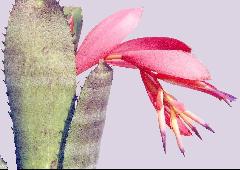
David Kruszewski is somewhat averse to repotting and uses extra large pots. In any event he brought in a Billbergia pyramidalis which has a huge flowerhead because of aforesaid pot culture. This was the form that used to be called var. concolor because the petals were supposed to be totally red but as we all know the petals have blue tips! Anyway, Judith Vane did bring up a query that I regret to say can only be answered in a technical manner. I hope you don’t mind! Why was the inflorescence so different to the other species? My answer at the time was because taxonomists saw similarities in the total floral structure. I have now had the chance to refer to the files in my den. Quesnelia is a genus very similar to Billbergia and yet has clustered inflorescences in Q. quesneliana and also Q. liboniana that looks like a typical Billbergia, Confused? Well, read on for more confusion. In 1852 Lemaire described Billbergia splendida and in 1854 de Jonghe described Billbergia croyana. In 1873 Lemaire changed his mind and for a short time accepted Billbergia but treated splendida and croyana under a new genus Jonghea. In 1889 Baker treated Jonghea croyana as a variety of Billbergia pyramidalis and Jonghea splendida as a variety of Billbergia thyrsoidea. I don’t know what Mez did in 1935 but Smith in 1979 had them both under Billbergia pyramidalis var. pyramidalis. I find the historical information fun but I was asked a question. Please don’t ask me what thyrsoid means because I will only say its meaning in the 1800’s was different to what it is today. If you are really keen the answer is in http://fcbs.org somewhere!
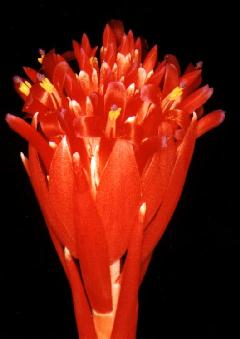
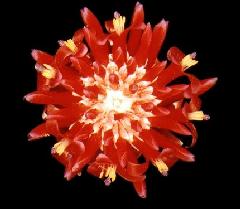
And now to the hybrids where most were of Australian origin. Those wishing to reminisce could go easily back to the 1960’s when much was done and the plants still prevail. ‘Muriel Waterman’ got several mentions including ‘Euphemie Waterman’ and ‘Muriel’s Grandchild’ if only because of the tenuous link with our Committeeman Colin Waterman. We assured him that Muriel was a Kiwi and the plant was named in her honour by Mulford Foster so many years ago. It is a great plant with good conformation but is a shy flowerer. The Cultivar Register tells us that there are several different clones around where the plant looks similar but there are differences in the inflorescence!
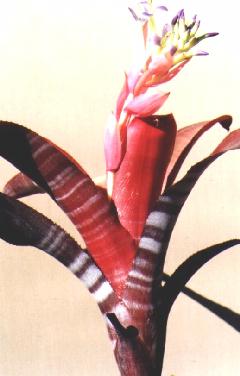
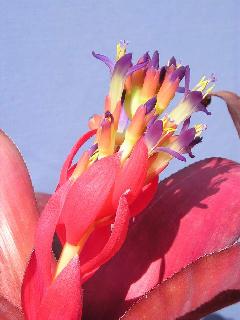
And so to Bill’s segment. Bill had bought an Orthophytum while on recent holidays in Victoria. We were able to confirm that it was O. saxicola. This species is an interesting one. There is a new Orthophytum on the scene – O. mucugense – which I have been busy translating from Portuguese. This comes from a waterfall area in Chapada Diamantina in Bahia, Brazil and gives an idea it would find it tough living in Adelaide! There was also discussion about all other orthophytums that have an inflorescence without a scape and is nestled in the centre of the leaf rosette, and those prickly ones that Len Colgan grows that do have a scape. Just where do you put Orthophytum saxicola when one variety has an inflorescence on a scape and the other variety where the scape is missing?! Bill’s is the variety without a scape!
It was great to see George at the meeting as he is always good for some involvement. This time he had brought in Canistropsis billbergioides ‘Citron’. This particular species is not easy to grow and yet 30 years ago everybody seemed to be growing it. Is there less hot air at meetings these days compared to days of yore?
There were also various Guzmania and Vriesea hybrids to look at as well as a Pitcairnia atro-rubens thinking of starting to flower. Vriesea ‘Main Roads’ was so named because it should have a strong white line in the centre of the leaf indicating the middle of the road. In this case excessive use of the road had almost obliterated the white line.
Bill seemed disappointed that his Tillandsia only had EM881303 on the label but I pointed out that this information was more important than allocating a species name to the plant. We know the ‘E’ stands for Renate Ehlers, and the ‘M’ for Mexico, the ‘88’ for 1988 and the 1303 the thirteenth plant found on day 03 of the trip! This plant has been discussed the world over because it is halfway between T. capitata and T. brachycaulos. And we know it comes from Poculta in Oaxaca.
George just had to confuse us with a plant in a VERY small pot where he had lost the label. Our guess was that it was T. recurvifolia. ALL members voted that Len Colgan’s Tillandsia stricta var. albiflora had blue petals in case he did not believe the Secretary on his return from overseas.
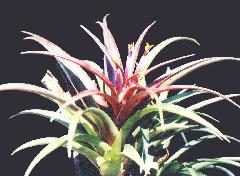

Finally Bill did his magician’s act by producing the smallest seedling from a plastic bag. You see, Bob McGregor had noticed this two leafed seedling on a dried Hoya leaf just hanging around in his garden. Consensus was that it had to have come from one of his Diaphoranthema close by and he had better give it the hurry on to see it flower.